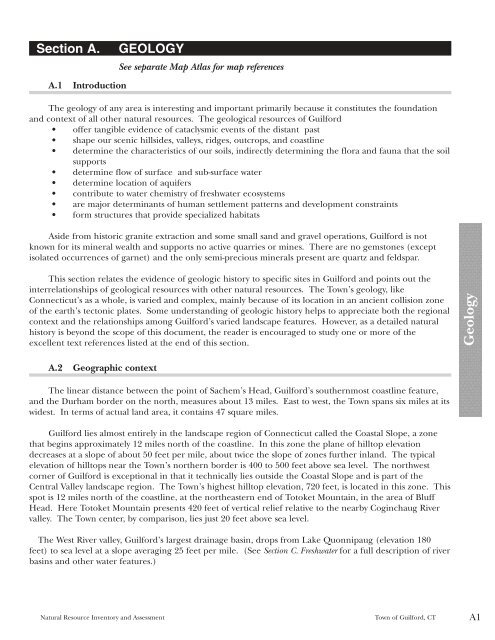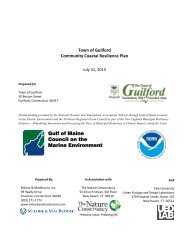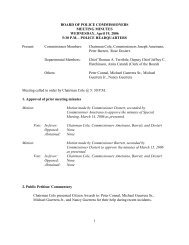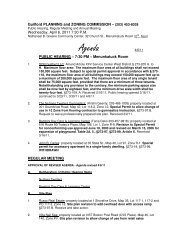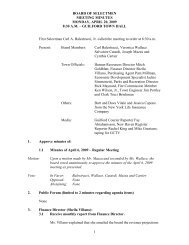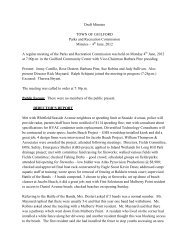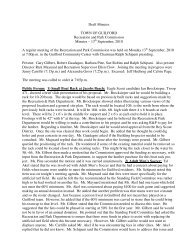Natural Resource Inventory and Assessment - Town of Guilford
Natural Resource Inventory and Assessment - Town of Guilford
Natural Resource Inventory and Assessment - Town of Guilford
You also want an ePaper? Increase the reach of your titles
YUMPU automatically turns print PDFs into web optimized ePapers that Google loves.
Section A. GEOLOGY<br />
A.1 Introduction<br />
See separate Map Atlas for map references<br />
The geology <strong>of</strong> any area is interesting <strong>and</strong> important primarily because it constitutes the foundation<br />
<strong>and</strong> context <strong>of</strong> all other natural resources. The geological resources <strong>of</strong> <strong>Guilford</strong><br />
• <strong>of</strong>fer tangible evidence <strong>of</strong> cataclysmic events <strong>of</strong> the distant past<br />
• shape our scenic hillsides, valleys, ridges, outcrops, <strong>and</strong> coastline<br />
• determine the characteristics <strong>of</strong> our soils, indirectly determining the flora <strong>and</strong> fauna that the soil<br />
supports<br />
• determine flow <strong>of</strong> surface <strong>and</strong> sub-surface water<br />
• determine location <strong>of</strong> aquifers<br />
• contribute to water chemistry <strong>of</strong> freshwater ecosystems<br />
• are major determinants <strong>of</strong> human settlement patterns <strong>and</strong> development constraints<br />
• form structures that provide specialized habitats<br />
Aside from historic granite extraction <strong>and</strong> some small s<strong>and</strong> <strong>and</strong> gravel operations, <strong>Guilford</strong> is not<br />
known for its mineral wealth <strong>and</strong> supports no active quarries or mines. There are no gemstones (except<br />
isolated occurrences <strong>of</strong> garnet) <strong>and</strong> the only semi-precious minerals present are quartz <strong>and</strong> feldspar.<br />
This section relates the evidence <strong>of</strong> geologic history to specific sites in <strong>Guilford</strong> <strong>and</strong> points out the<br />
interrelationships <strong>of</strong> geological resources with other natural resources. The <strong>Town</strong>’s geology, like<br />
Connecticut’s as a whole, is varied <strong>and</strong> complex, mainly because <strong>of</strong> its location in an ancient collision zone<br />
<strong>of</strong> the earth’s tectonic plates. Some underst<strong>and</strong>ing <strong>of</strong> geologic history helps to appreciate both the regional<br />
context <strong>and</strong> the relationships among <strong>Guilford</strong>’s varied l<strong>and</strong>scape features. However, as a detailed natural<br />
history is beyond the scope <strong>of</strong> this document, the reader is encouraged to study one or more <strong>of</strong> the<br />
excellent text references listed at the end <strong>of</strong> this section.<br />
A.2 Geographic context<br />
The linear distance between the point <strong>of</strong> Sachem’s Head, <strong>Guilford</strong>’s southernmost coastline feature,<br />
<strong>and</strong> the Durham border on the north, measures about 13 miles. East to west, the <strong>Town</strong> spans six miles at its<br />
widest. In terms <strong>of</strong> actual l<strong>and</strong> area, it contains 47 square miles.<br />
<strong>Guilford</strong> lies almost entirely in the l<strong>and</strong>scape region <strong>of</strong> Connecticut called the Coastal Slope, a zone<br />
that begins approximately 12 miles north <strong>of</strong> the coastline. In this zone the plane <strong>of</strong> hilltop elevation<br />
decreases at a slope <strong>of</strong> about 50 feet per mile, about twice the slope <strong>of</strong> zones further inl<strong>and</strong>. The typical<br />
elevation <strong>of</strong> hilltops near the <strong>Town</strong>’s northern border is 400 to 500 feet above sea level. The northwest<br />
corner <strong>of</strong> <strong>Guilford</strong> is exceptional in that it technically lies outside the Coastal Slope <strong>and</strong> is part <strong>of</strong> the<br />
Central Valley l<strong>and</strong>scape region. The <strong>Town</strong>’s highest hilltop elevation, 720 feet, is located in this zone. This<br />
spot is 12 miles north <strong>of</strong> the coastline, at the northeastern end <strong>of</strong> Totoket Mountain, in the area <strong>of</strong> Bluff<br />
Head. Here Totoket Mountain presents 420 feet <strong>of</strong> vertical relief relative to the nearby Coginchaug River<br />
valley. The <strong>Town</strong> center, by comparison, lies just 20 feet above sea level.<br />
The West River valley, <strong>Guilford</strong>’s largest drainage basin, drops from Lake Quonnipaug (elevation 180<br />
feet) to sea level at a slope averaging 25 feet per mile. (See Section C. Freshwater for a full description <strong>of</strong> river<br />
basins <strong>and</strong> other water features.)<br />
<strong>Natural</strong> <strong>Resource</strong> <strong>Inventory</strong> <strong>and</strong> <strong>Assessment</strong> <strong>Town</strong> <strong>of</strong> <strong>Guilford</strong>, CT A1<br />
Geology


